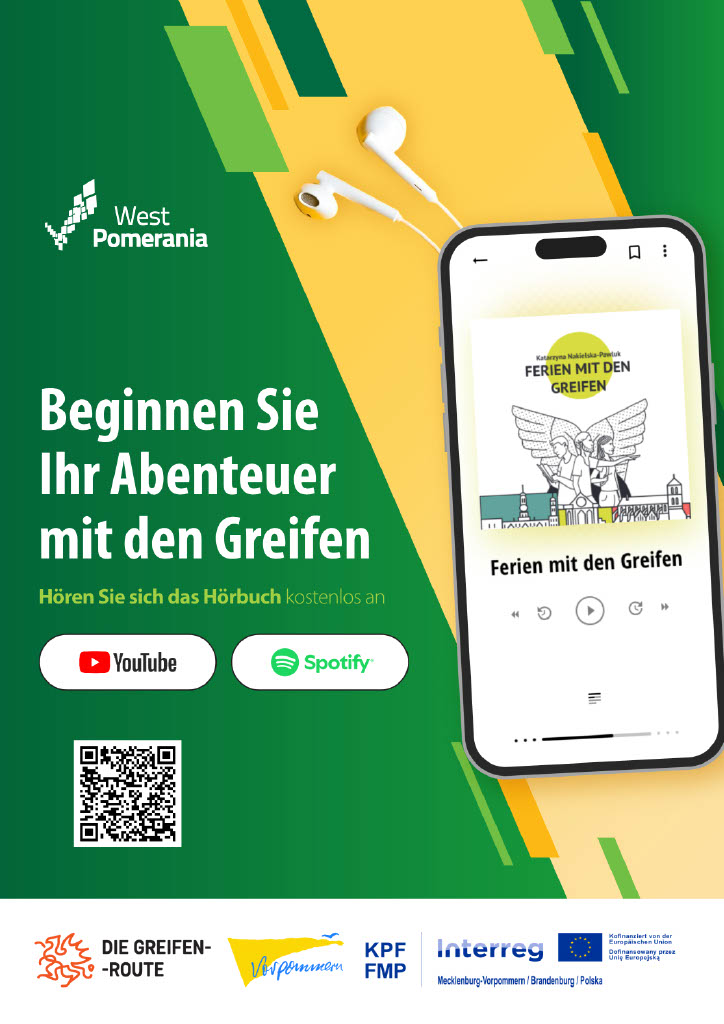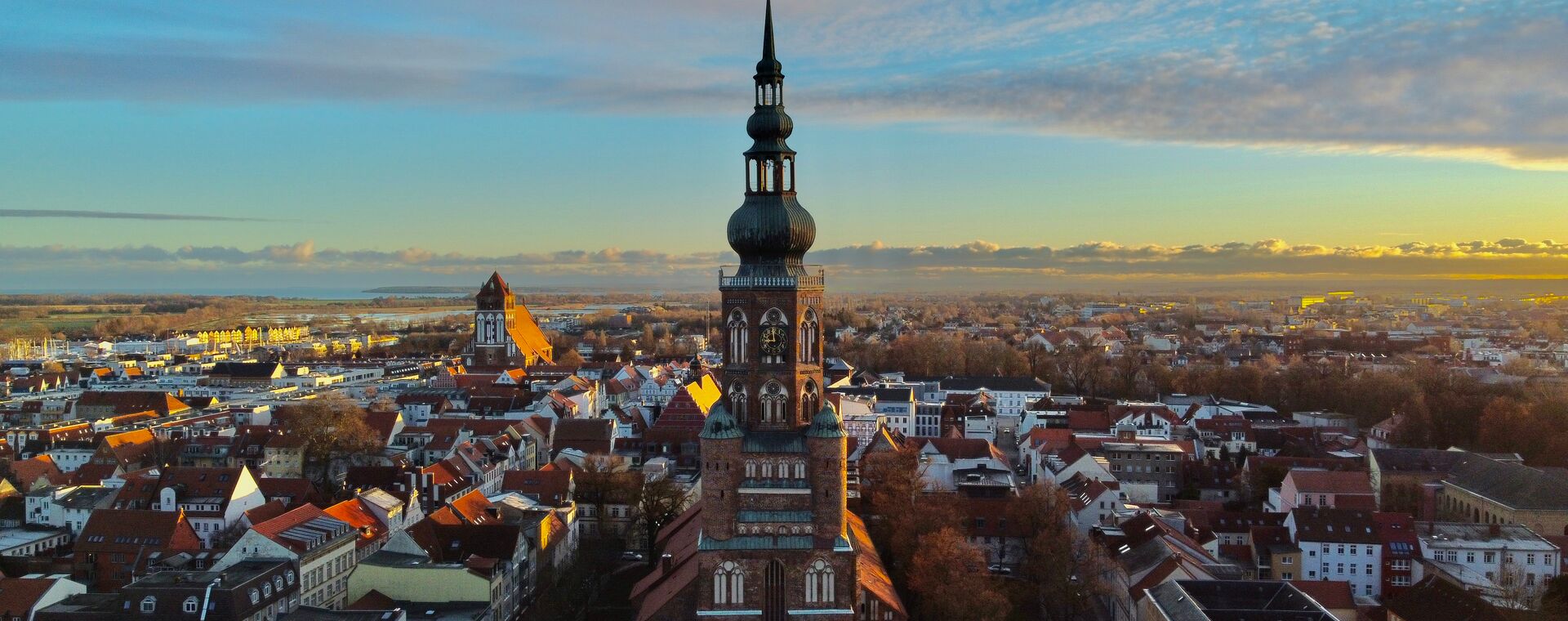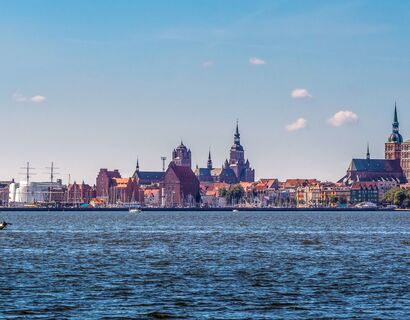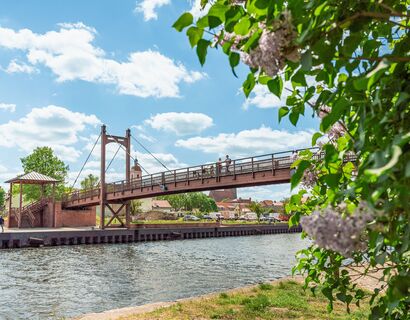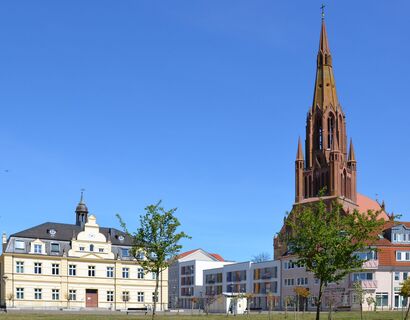University and Hanseatic City of Greifswald
In the north-east of Germany, between the two largest German islands of Rügen and Usedom, lies the versatile university and Hanseatic city of Greifswald.
.jpg)
Cistercian monks founded the Hilda monastery in 1199, which can still be visited today as a ruin in Eldena. In 1250, Duke Wartislaw III granted the settlement Lübische Recht and elevated it to the status of a town. As a member of the Hanseatic League, Greifswald experienced an economic boom in the Middle Ages. Today, the city is a modern and important business, science and technology location.
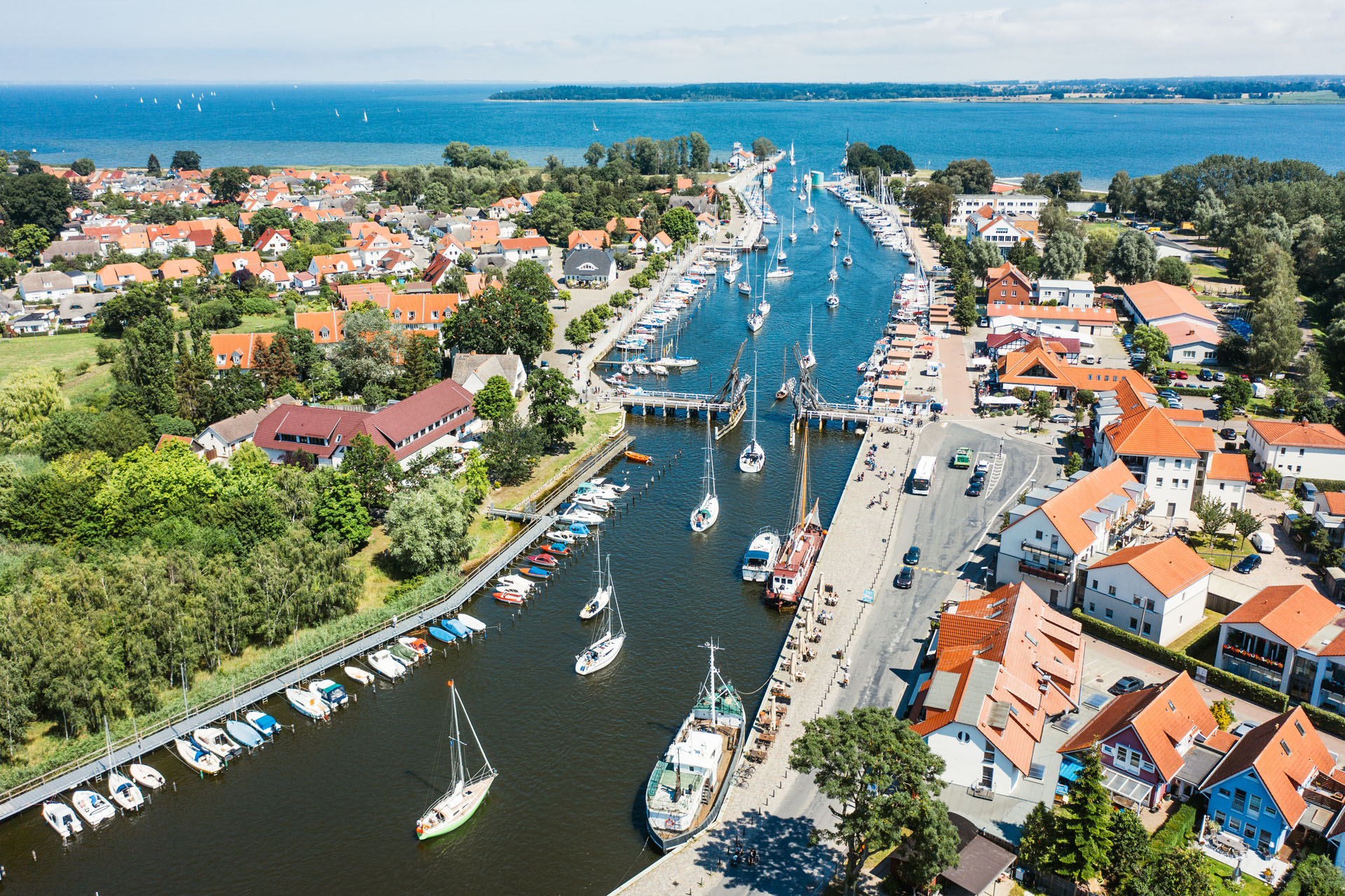
Top facts about the city of Greifswald
Cultural
The three large parish churches - St. Mary's, St. Nicholas Cathedral and St. Jacob's Church - are impressive witnesses to the era of brick architecture. If you visit the university and Hanseatic city from the north, you will see the silhouette of the city from the perspective of Caspar David Friedrich, as it can be seen in his paintings. Paintings by the city's famous painter are on display in the picture gallery of the Pomeranian State Museum. In the historic old town area with its Gothic gabled houses on the market square and St. Spiritus, which is now used for cultural purposes, is the main university building with the assembly hall and the dungeon. Visits are possible by prior arrangement.
Many well-maintained cycling and hiking trails offer the opportunity to explore the university and Hanseatic city of Greifswald and its surroundings individually. In the summer months, things get cultural: for example at the jazz events in the Eldena monastery ruins and at concerts in the cathedral as part of the Bach Week.
Wieck & Eldena
The listed fishing village of Wieck is located directly on the Greifswald Bodden and has room for numerous boats. Maritime flair and coastal romance await you here.
A special attraction in Wieck is the hundred-year-old wooden drawbridge. Built according to the Dutch model, it is still fully functional today. The idyllic harbor offers space for many ships. For example, the schooner brig "Greif", which was built from steel in Rostock-Warnemünde in 1951, is moored here. There is an extensive chronicle on board the sail training ship, which provides information about the history of the ship and its crew.
Experience the maritime flair of yesterday and today: The Gaffelrigg fishing festival takes place in Wieck every year on the third weekend in July. Alongside the Hanse Sail, the fishing festival in Wieck is the largest maritime festival in Mecklenburg-Vorpommern.
Cozy cafés and restaurants offer guests in Wieck a place to relax and enjoy regional culinary delights. A stroll past the many thatched houses with a view of the Greifswald Bodden is definitely worthwhile.
And right next to Wieck is Greifswald's town beach in Eldena. Here you can relax on sunny days and enjoy the wonderful weather.
Cycling & hiking routes in Greifswald and the surrounding area
Excursion destinations and sights in Greifswald and the surrounding area
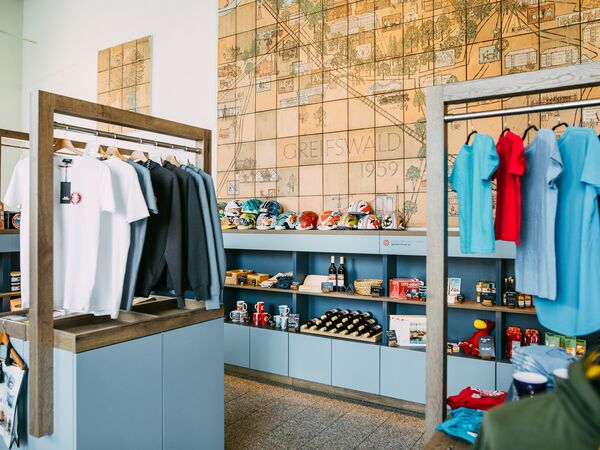
Greifswald Information
Accommodation, souvenir sales, ticket service and the best advice - the Greifswald Information Office is the first port of call in the university and Hanseatic city, and not just for holidaymakers.
The Greifswald Information Center is located in the Rathaus arcades on the market square. It offers visitors and residents of the city a wide range of souvenirs as well as information on sights, events and excursion tips. The friendly team on site offers support with booking accommodation, event tickets and guided tours of the city and is available to answer any questions about an eventful stay in Greifswald and the surrounding area. The Greifswald Information Office is also the starting point for various public city tours through the historic old town and Germany's largest museum harbor.
Greifswald Information Service
" Arrangement of accommodation
" Guided tours of the city and events
" Dispatch of information material
" Group reservations
" Advice on activities, excursion destinations and events
" Event tickets
" Cycling maps
" Souvenirs, vouchers, postcards etc.
April to October
Mon-Fri 10am-6pm
Sat 10-14 h
Sun 10-14 h (June - September)
November to March
Mon-Fri 10 a.m.-5 p.m.
Sat/Sun closed
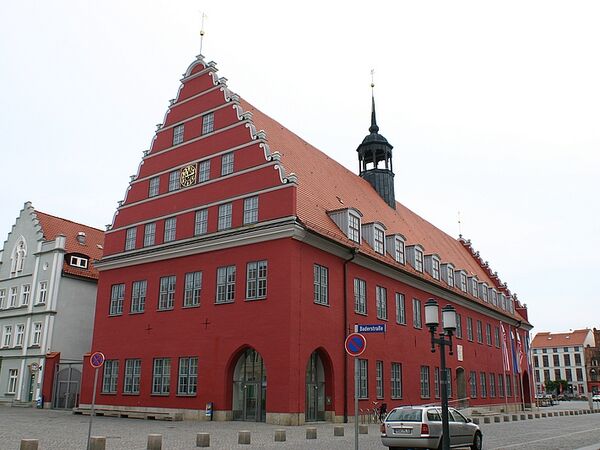
Travel agency greetings from Atlantis
Whether booking an attractive and interesting package deal, themed tours or as your travel specialist for boat trips on the Mecklenburg Lake District and along the Baltic coast. At the travel agency Grüße aus Atlantis you will receive your offer.
By booking one of our attractive and interesting package deals, you can plan your stay in Greifswald in advance. Thematic tours will introduce you to the secrets of the Hanseatic city and the Western Pomerania region. For groups, we offer tailor-made packages with accommodation, guided tours, supporting programs and transfer services. Go on a journey of discovery with us on a walk along the picture trail, or with the night watchman - at sea or cross-country in a Land Rover.
As your independent travel specialist, we can provide you with comprehensive advice on boat trips on the Mecklenburg Lake District, the Peene or along the Baltic coast. Houseboats, motor yachts and floating vacation homes at numerous charter bases throughout Mecklenburg-Vorpommern. Those who prefer to discover the Baltic coast under white sails can board a tall ship. We offer day trips, romantic evening trips and trips lasting several days to destinations all over the Baltic Sea.
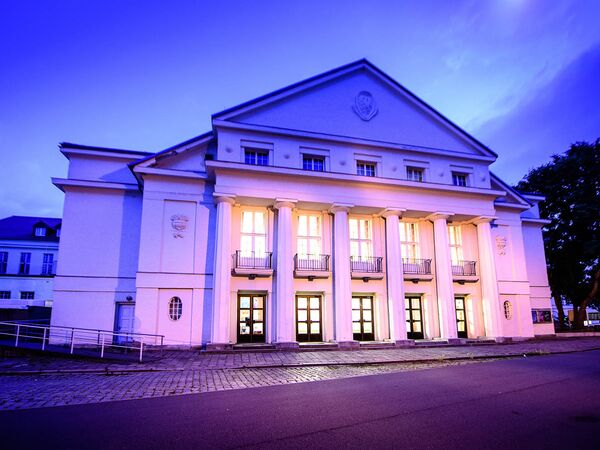
Theater and Stadthalle Greifswald
Theater Greifswald is part of Theater Vorpommern - together with Theater Stralsund since 1994 and Theater Putbus since 2006.
The administrative management, the theater, the ballet and the philharmonic orchestra are based here. The theater building was opened on October 10, 1915. After extensive renovation and restoration work, the Stadthalle was reopened on December 18, 2009. Since then, the theater and town hall, together with the Kaisersaal and the Rubenowsaal, have once again formed a single building complex.
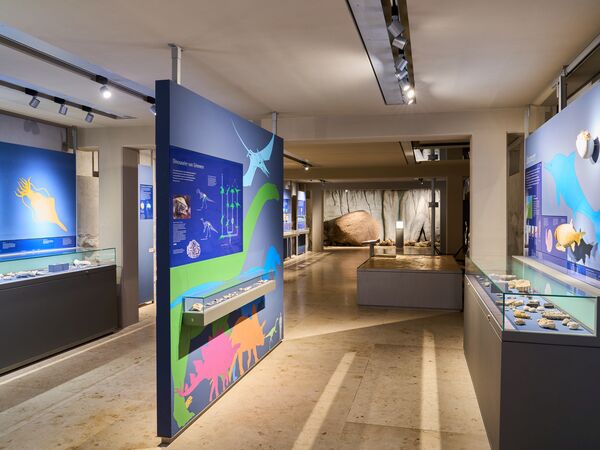
Pomeranian State Museum
History and art await you at the Pomeranian State Museum - in an award-winning ensemble of buildings that impressively combines Gothic, Classicist and contemporary architecture. The latest special exhibition "Heimatstadt" on Greifswald's famous son, the Romantic artist Caspar David Friedrich - until January 5, 2025.
The year 2025 at the Pomeranian State Museum
The permanent exhibition is open all year round - 14,000 years of Pomeranian history await you! There is also an extensive program of events with lectures, guided tours, art breaks and much more - including the anniversary "775 years of Greifswald".
Special exhibitions
A new look
In spring 2025, we will once again open our convent building and present moments from the art collection. Look forward to seeing old acquaintances such as Frans Hals and Vincent van Gogh, meet artists in new combinations and discover familiar works as well as those that have been waiting to make their appearance.
New, white ceramics from Szczecin
24.05.-31.08.2025
The aim of the cabinet exhibition is to reinterpret the craft tradition known as "Szczecin ware" in the light of contemporary artistic and cultural contexts. The works on display were created as part of ceramic workshops in which the participants set themselves the task of engaging in a creative dialog with the historical heritage.
Viking gold. Treasure policy since 1800
Traveling exhibition with digital presentation
October 2025 to January 2026
Treasures from the Viking Age (approx. 800-1100) are repeatedly found in the Baltic Sea region. It was the same even earlier. When these treasures are found, complex processes of appropriation begin: Who is allowed to keep the "Viking gold"? Where will it be displayed? Who identifies with it? Who distances themselves from it? And how do these processes change over time? The exhibition "Treasure Politics" shows that the appropriation of cultural heritage and its demarcation are politically charged.
On the way to the Gallery of Romanticism
After the big anniversary in 2024, Caspar David Friedrich remains relevant: the new Gallery of Romanticism puts the most famous Pomeranian in the spotlight permanently. The topping-out ceremony was celebrated in July 2024, so it's only a matter of time before the opening! There you will be greeted by a chapel that uses multimedia to introduce you to Friedrich's poetic imagery. You can experience how his paintings took shape, immerse yourself in the originals and find out what kind of person the soap farmer's son from Swedish Pomerania was. Or did you know that Caspar David Friedrich bred canaries and was famous and infamous for his enormous full beard?
Pomerania - Land by the sea
Take your time to discover the eventful history of the region on both sides of the Oder! From the first hunters and gatherers to the 20th century, 14,000 years of history await you - with impressive exhibits, elaborate media stations and installations. Discover exciting facts from prehistory and the Middle Ages, from Stone Age megalithic tombs, Slavic trading networks and the heyday of the Hanseatic League. Find out why Martin Luther, a Saxon princess and a Pomeranian duke gathered on the unique Croy carpet, why the Swedes completely surveyed their province of Pomerania and how fishing villages became fashionable Baltic seaside resorts. The 20th century, with its ruptures and continuities, is illuminated by objects and eyewitness accounts - from the World Wars to flight and expulsion, "East Mecklenburg" in the GDR, "West Pomerania" in Poland and the "Pomeranian Renaissance" after German reunification.
A glass road connects the buildings of the museum complex.
If you've seen a lot, you need to take a break. The Franziskaner monastery garden, the museum store and the museum restaurant "Natürlich Büttners" - Restaurant & Manufaktur invite you to take a break.
See you soon at the Pomeranian State Museum
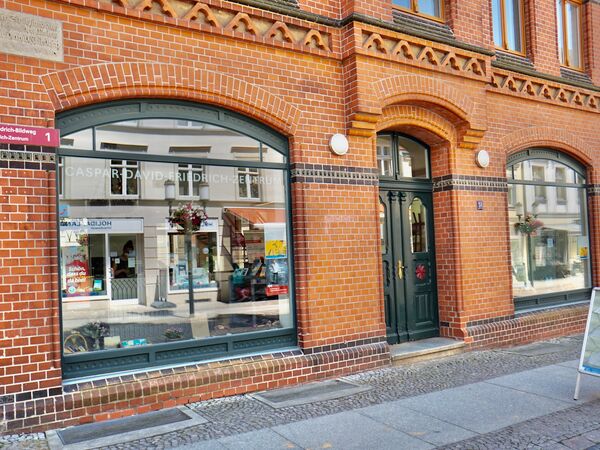
Caspar David Friedrich Center
The Caspar-David-Friedrich-Zentrum, opened in 2004 in the historic Seifensiederei and expanded in 2011 to include the entire former residential and commercial building of the Friedrich family, commemorates the great painter and greatest son of the city of Greifswald. It is also a museum, documentation and research center. Caspar David Friedrich was born here on September 5, 1774.
Visitors can see their father's old soap-making workshop, the family cabinet with the family tree, the Rügen and Eldena rooms with famous motifs from Friedrich's work and the Caspar David Friedrich Gallery. The tour offers comprehensive information on Friedrich's origins, career and creative style as well as on the history of the Friedrich family and their home and business premises, which is also the subject of a long-term research project by the Caspar David Friedrich Society. Changing exhibitions of contemporary art in the Caspar David Friedrich Gallery bear witness to the enduring fascination and impact of Friedrich's work and historical Romanticism.
Thanks to its location in the heart of Greifswald's old town, the center is a particularly attractive destination for anyone who wants to follow in the artist's footsteps in his hometown. In the immediate vicinity is St. Nikolai Cathedral, where Caspar David Friedrich was baptized, and it is only a few minutes' walk to the Pomeranian State Museum with its original Friedrich paintings.
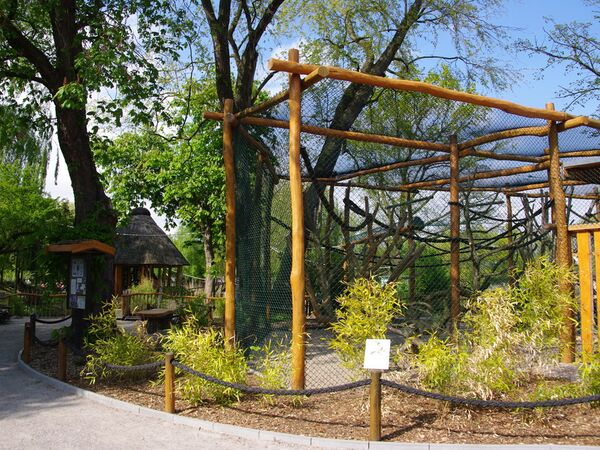
Greifswald Zoo
At Greifswald Zoo you can discover many new things at any time of year. Our park with its inhabitants and the natural history house with zoo café invite you to visit. Zoo school, guided tours, children's birthday parties and family celebrations on request.
An experience for all the senses
Our home animal park in Greifswald is worth a visit at any time of year. Lovingly and naturally designed animal enclosures always provide new
interesting insights into the fascinating world of different animal species. Whether meerkats, liszt monkeys, coatis and raccoons,
porcupines, dingoes or swamp beavers, there is always something to marvel at somewhere. The encounters in the walk-in enclosures for white storks, pygmy goats and kangaroos are particularly intense.
the impressive capybaras up close at feeding time. Discover the capuchin monkeys on their island and the diversity of our bird species. A special experience next to the bee house is our chick house, where you can watch the chicks hatch.
can be observed as they hatch.
Relax in the scenic park with a view of the swan pond. On your tour, numerous "play elements for the development of the senses" such as the water whirlpool and bird call simulator as well as our large water and adventure playground invite you to explore.
to explore. Throughout the park you will find cozy places to sit and shelter in bad weather and visit the zoo school and the natural history house.
Enjoy a small snack in a cozy atmosphere in the zoo café!
We offer by arrangement: zoo school, project and hiking days, guided tours, children's birthday parties and barbecues in the park and celebrate birthdays, family parties and club celebrations in the TIERPARKCAFÉ.
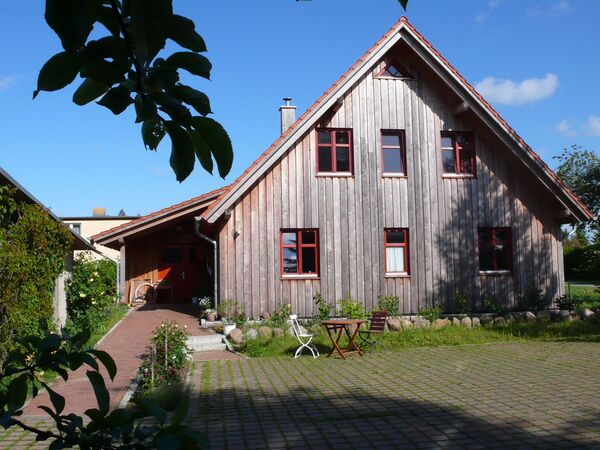
Guesthouse Köhler
Welcome to Gästehaus Köhler! You will find us in the countryside, about 7 km from Greifswald's market square. We speak German and English and are child- and pet-friendly and offer tajine cooking for enthusiasts or the curious
We offer you three rooms in each of three different houses: a stone house, a wood100 house and a log house made of Canadian cedar. The double rooms in the cedar house each have an integrated mini-kitchen and bathroom. Guests in the other houses share bathrooms and kitchens. In summer, there are no limits for barbecue enthusiasts. An oven will soon be built next to the pavilion. I can already smell the aroma of crusty bread, delicious cakes and pizza. If you book breakfast, I will gladly try to fulfill your wishes, as well as our chickens. There are several possibilities to buy good food here, e.g. in the farm store of Dexterhof Tammert near us. On our homepage you can also see the breakfast and social room, where regular events take place, e.g. lectures on various topics and Ayurvedic cooking.
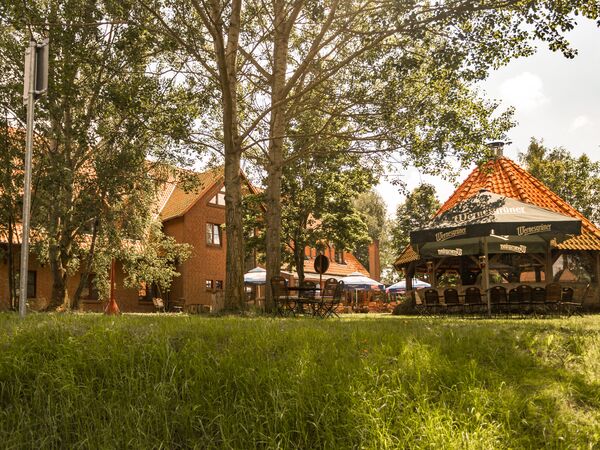
Stettiner Hof
Welcome to the Stettiner Hof! Enjoy your stay away from the hustle and bustle and traffic noise, right at the gates of the Hanseatic city of Greifswald. The charming ambience and regional cuisine of the hotel will win you over. Your hotel offers 21 comfortable rooms and three spacious suites. W-LAN is free of charge throughout the hotel. We wish you a pleasant stay.
The Stettiner Hof is a small, owner-managed hotel with character.
Since 1992 we have wanted to make you feel welcome in this place.
We would also like to give your celebration or event a good address and will be happy to organize it for you.
Travelers for one night are just as welcome here as business people, families and all other guests.
Many free services and a parking lot are available to you during your stay.
The rooms and suites of various sizes are located on the first floor and on two floors and can be reached via a staircase.
An extra bed or bringing your pet is possible for a small additional charge. In the barrier-free restaurant and winter garden with variable seating, we spoil you with changing specialties.
There is also a spacious summer garden with a chain carousel and a historic field train, which can be used by young and old.
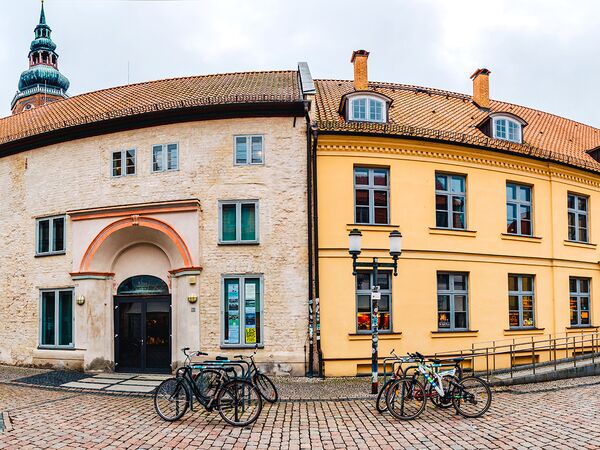
Socio-cultural center St. Spiritus
The Socio-Cultural Center offers an atmospheric platform for many events in a historic setting: Concerts with live music of various genres, puppet shows, theater, cabaret and other live events. There are also changing art exhibitions, regular drawing and ceramics courses and art workshops.
The socio-cultural center is located in the heart of Greifswald in a listed ensemble whose oldest components date back to the 13th century. An idyllic inner courtyard with historic half-timbered buildings houses artistic workshops and is the venue for open-air concerts in summer. The event hall has an eventful history - Greifswald's oldest church building, metal foundry, bakery - today concerts from classical music to jazz, blues to rock take place here all year round, as well as children's theater, performances, lectures, readings and seminars. A gallery on the upper floor shows changing exhibitions by local and national artists. Artistic techniques are taught in courses and workshops - such as screen printing, intaglio printing, silversmithing, stamping and linocut, bookbinding and much more. Two choirs rehearse regularly in the house, there is a singing group, children's chess and meetings of senior citizens' groups. During the vacations, there are hands-on activities for children and puppet theater. Another focus is intercultural encounters with the "Intercultural Café", which takes place every 14 days. The main task of the city's socio-cultural center is to enable as many people of all ages as possible to participate in culture. The aim is to encourage active involvement and participation. Highlights in the region's cultural calendar such as the "Literaturfrühling", the "Nordische Klang", the city festival "Ein Tag mit Caspar-David-Friedrich", the "Fantakel-Figurentheaterfestival", the "Interkulturelle Woche", the "Tanztendenzen" and the "polenmARkT" are hosted by St.Spiritus.

Church of St. Jacobi Greifswald
St. Jacob's Church, dedicated to the patron saint of fishermen, was first mentioned by name in 1280.
The brick church consists of a three-aisled hall and the somewhat narrower square west tower. Until a fire in 1955, the originally taller tower still had a half-timbered extension, which was not restored when the tower roof was reconstructed.
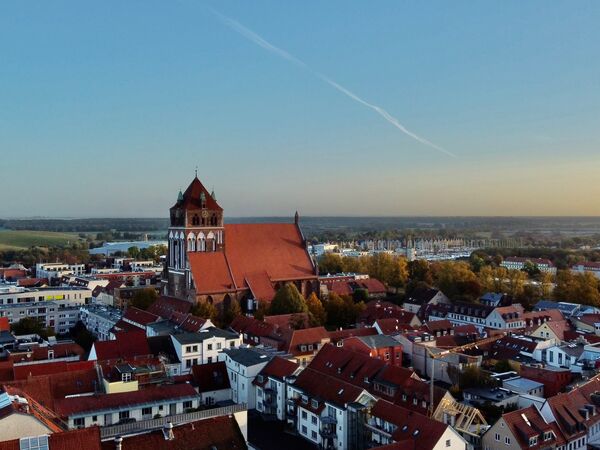
St. Mary's Church Greifswald
St. Mary's Church is a parish church in the middle of Greifswald's old town. St. Mary's Church can be visited after the Sunday service until 1 pm. The following opening hours apply in June, July and August: Monday to Friday from 10 am to 6 pm and Saturday 11 am to 3 pm. You can register for guided tours of the church at the church office or in the church.
Construction of St. Mary's Church, also known as the "Fat Marie" by the people of Greifswald, probably began in the middle of the 13th century. Together with the two other town churches, St. Nikolai and St. Jacobi, it was first mentioned in documents in 1280. The church was built as a hall church and is today one of the most impressive examples of North German Brick Gothic architecture. Worth seeing inside the church are the preserved colorful paintings (14th century), the medieval court hall, the large load-bearing treadmill in the tower, the memorial chapel, the altarpiece - a replica of Correggio's "Holy Night" and the richly decorated pulpit (16th century).
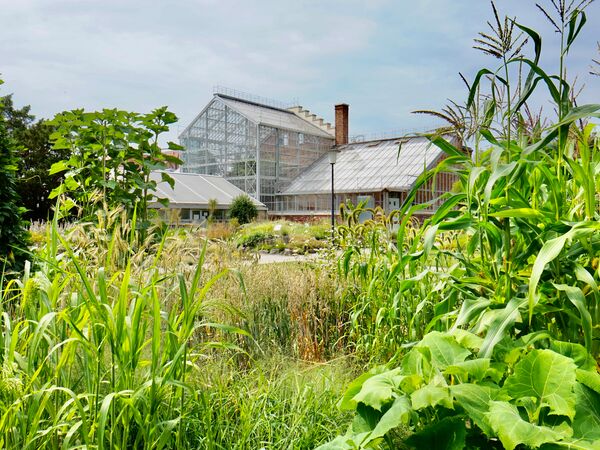
Greifswald Botanical Garden
The botanical garden was founded in 1763 and belongs to the University of Greifswald. It consists of 16 greenhouses and outdoor areas, ponds, 8000 different plant species including: Cacti, giant water lilies, tropical orchids and aromatic and medicinal plants. The construction of the new botanical garden (arboretum) began in 1934 under botany professor Paul Metzner (1893-1968) on Friedrich-Ludwig-Jahn-Straße.
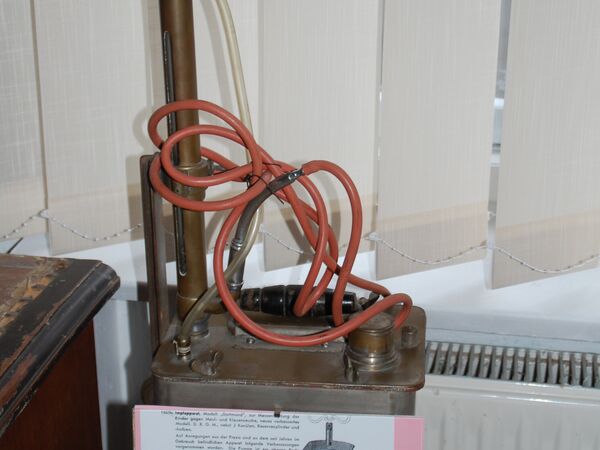
"UNS Riems" museum on the cradle of virus research
One of the most modern research institutes for animal diseases is located on the small island of Riems between Greifswald and Stralsund. Research into avian flu, for example, is also carried out here. "UNS Riems" is a regional veterinary history museum and is dedicated to the beginnings of research by the founder Friedrich Loeffler.
The museum complements the history of virology and Friedrich Loeffler, which is depicted in the Loefferhaus on the island. It also deals with the development of epidemic research (beyond foot-and-mouth disease) over the past centuries. It depicts the history of research on the island, but also the life and work of the people on Riems and in Riemserort from 1910 to the present day.
The exhibition is open on the last Saturday of every month from 1 to 5 pm. Guided tours start every hour on the hour. Visits on any other day of the week are also possible by prior arrangement at museum-uns-riems@web.de!
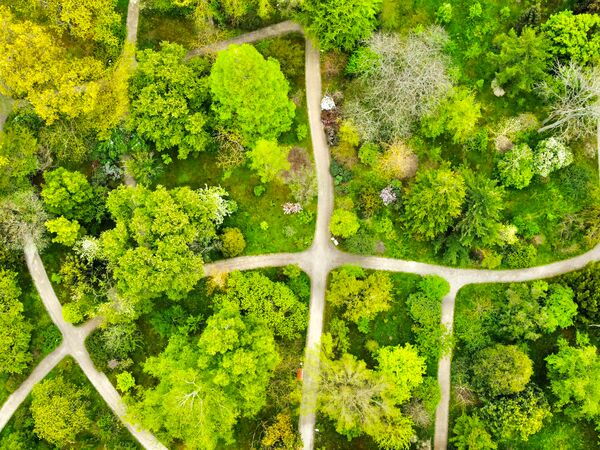
Arboretum of the University of Greifswald
Knowledge about plants is vividly conveyed here. Get to know the diversity of the plant world on a tour of the University of Greifswald's Botanical Garden and Arboretum.
The arboretum, which was established in 1934, is part of the University of Greifswald's Botanical Gardens. The grounds are arranged according to geographical aspects. There is a water lily pond in the central part of the arboretum. The arboretum is open from April to October from 9.00 am to 6.00 pm.
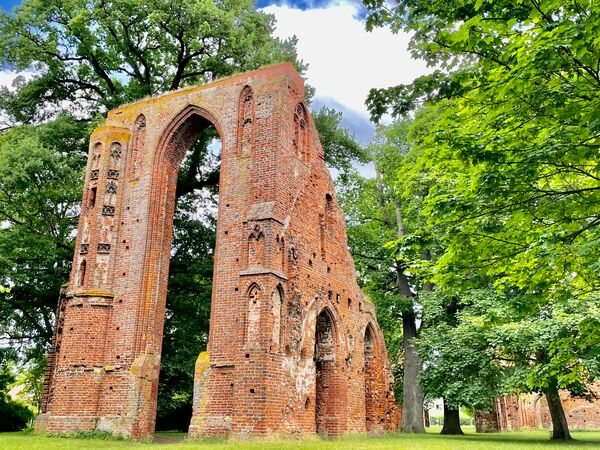
Eldena monastery ruins
The monastery ruins and park are a popular excursion destination for Greifswald residents and their guests. The monastery ruins are also the starting and finishing point of the themed cycle path "Route of North German Romanticism", which traces the stations and lives of the North German Romantics of Western Pomerania.
Caspar David Friedrich (1774-1840) made the ruins of the medieval Cistercian monastery of Eldena widely known with his paintings and drawings. The remains of the once important monastery are embedded in a park with old trees, including 180-year-old oaks, which illustrate Friedrich's ideas and characterize the romantic atmosphere of the grounds. The main accent of the ruins is the imposing west façade of the former monastery church with its high ogival window opening.
The monastery of Hilda (Eldena) was founded in 1199 after Cistercian monks were forced to abandon their monastery in Dargun as a result of armed conflict. The new monastery was built to the east of the future town of Greifswald, at the mouth of the River Ryck into the Danish Wiek. In 1248, the "oppidum Gripheswald" was first mentioned in a document among the monastery's possessions and in 1250, today's Greifswald was granted town charter. The monastery ruins are located in the Eldena district, in the immediate vicinity of the fishing village of Wieck and the Greifswald Bodden.
In the Middle Ages, Eldena was the most important monastery in the region, the economic and spiritual center of the area and reached its heyday around 1400. From the early 13th century to the beginning of the 15th century, it was structurally designed to reflect its importance. The monastery existed until the Reformation in the region in 1533 and subsequently fell into disrepair.
In 1634, the University of Greifswald received the Office of Eldena from the last Duke of Pomerania, Bogislaw XIV, and with it the monastery grounds and associated land. After plundering by imperial and Swedish troops during the Thirty Years' War, the remains of the medieval monastery complex fell into disrepair. From the second half of the 17th century, they were even used as a quarry for fortifications and university buildings in Greifswald.
The rescue of the complex is largely due to the intervention of the Prussian Crown Prince Friedrich Wilhelm (1795-1861, later King Friedrich Wilhelm IV), who was enthusiastic about romantic ideas. In 1827, he found the ruins in a dilapidated state. As a result, the first clearing and restoration work was carried out between 1828 and 1832 and a park was laid out to make the site accessible. Oak trees were planted in place of the missing nave pillars. The merging of the eternally recurring nature with the venerable architectural evidence of an irretrievably past time carries a profound symbolism that still captivates today's visitors at all times of the year and day.
Caspar David Friedrich, born in Greifswald in 1774, made the Eldena monastery ruins world-famous. He is now regarded as the most important painter and draughtsman of the early German Romantic period and used sketches of the monastery ruins as models for his paintings "Winter", "Monastery Ruins in the Giant Mountains" and "Abbey in Eichwald", among others. Some of his works are on display in the Pomeranian State Museum. In the Caspar David Friedrich Center in Greifswald's city centre, you can experience the life and work of the painter in an impressive way.
The post-Reformation history of the estate includes the expansion of the Amtsgut and the founding of an agricultural academy in 1835, which existed until 1876. The remaining monastery buildings were also used for agricultural purposes.
The monastery ruins have been owned by the University and Hanseatic City of Greifswald since 1937. Nowadays, the monastery ruins and the surrounding park are a popular local recreation area, a landmark of the town and a backdrop for filming and various events. In summer, there are regular theater performances, the Eldena Monastery Market (since 2014), the Eldena Jazz Evenings (since 1981) and other concerts and events. The monastery ruins are a stop on the Caspar David Friedrich Picture Trail and the European Route of Brick Gothic.
Parking & directions: https://www.greifswald.de/de/freizeit-kultur/veranstaltungen/maerkte/klostermarkt/anfahrt-klosterruine-eldena/
Route of North German Romanticism: Eldena monastery ruins - Friedrich's favorite motif
Caspar David Friedrich was born in Greifswald on September 5, 1774 and is considered the most important painter and draughtsman of early German Romanticism. In his paintings "Winter" and "Abbey in Eichwald", he used sketches of the ruins of Eldena Abbey as models, making them world-famous. During his visits home, Caspar David Friedrich constantly rediscovered the architecture of the monastery ruins. He drew it from all perspectives. The high west façade was of particular interest to him, as it forms the focal point of many of his works. His paintings brought the ruins into the public eye. This is the starting and finishing point of the themed cycle route "Route of North German Romanticism".
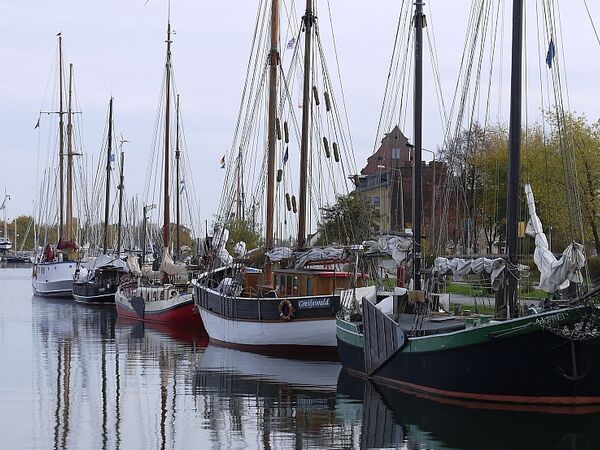
Museum harbor Greifswald
Gaff-rigged ketch and schooner, seaquat and ram ship, cruiser and dinghy - around 45 old ships characterize the image of the museum harbour in Greifswald, which was founded in 1991 based on the model of the museum harbours in Flensburg and Hamburg. This was the Hanseatic city's response to the increased interest in historic ships and traditional seamanship.
As part of the old city harbour, the museum harbour stretches from the Steinbeck Bridge to the old granary and characterizes the maritime flair of the Hanseatic city. The oldest ship that visitors can admire in the museum harbor is the Zeesboot "Pommerland" from 1880. www.museumshafen-greifswald.de lists all the ships moored here. 15 of them offer excursions and sailing trips. You can also take part in the annual gaff rigging.
By the way: The Greifswald Museum Harbour Association also organizes group tours of the museum harbour and the museum shipyard, where old ships are restored, on request.

Marina Greifswald on the Ryck
... in the middle of the Hanseatic city of Greifswald. A modern, well-equipped marina with comprehensive service is a matter of course. But a marina in the heart of a historic old town is unique. Because our Marina Yachtzentrum is ideally located on the River Ryck in the heart of Greifswald. Whether restaurant, theater, museum, cinema, shopping or doctor: from your berth you can reach everything within a few minutes' walk.
The marina is located in the heart of Greifswald on the River Ryck. Thanks to its central location, the theater, museum, cinema, restaurants, doctors and stores are just a few minutes' walk from the berth.
The marina has jetties with 230 berths and sanitary facilities. The water depth is 2.5 - 3.5m. Access is via the barrier with transponders or mooring cards. A visitor parking lot is also available. A shipyard directly connected to the marina and the service companies on the grounds of the yacht center offer various services for yachts.
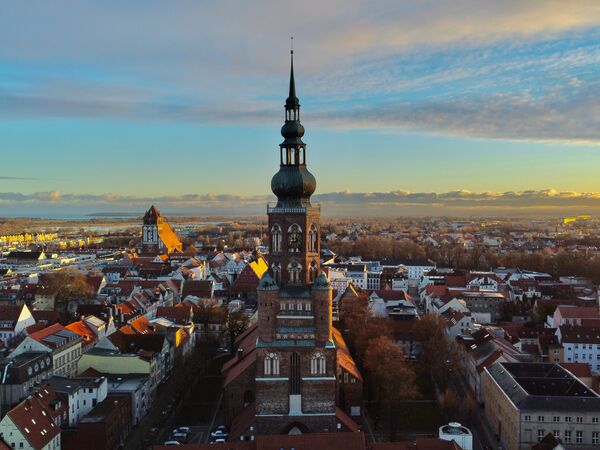
St. Nikolai Cathedral Greifswald
Greifswald Cathedral is one of the most beautiful sacred buildings in northern Germany. With its 100 m high tower, it towers over the Hanseatic city of Greifswald. From its tower gallery, you have an impressive view as far as the island of Rügen.
The slender baroque onion dome with two lanterns replaced the Gothic spire in 1652. The University of Greifswald was opened in St. Nikolai in 1456. Today it is the venue for the Greifswald Bach Week.
Protestant cathedral, first mentioned in a document in 1280, nine-and-a-half bay brick basilica with a choir closed on three sides, chapel extension and sacristy on the north side, 1st half of the 15th century incorporating the predecessor building of a five-bay, three-aisled brick hall church, extended around 1400 to include a four-and-a-half bay choir and surrounding chapel wreath.
The painter Caspar David Friedrich made the church in his home town world-famous. The parish church only became a cathedral when the episcopal see of the Pomeranian Protestant Church was moved from Szczecin to Greifswald in 1947. The tapered tower with its onion dome and four corner towers is particularly striking. The light-flooded basilica is the venue for the annual Greifswald Bach Festival.
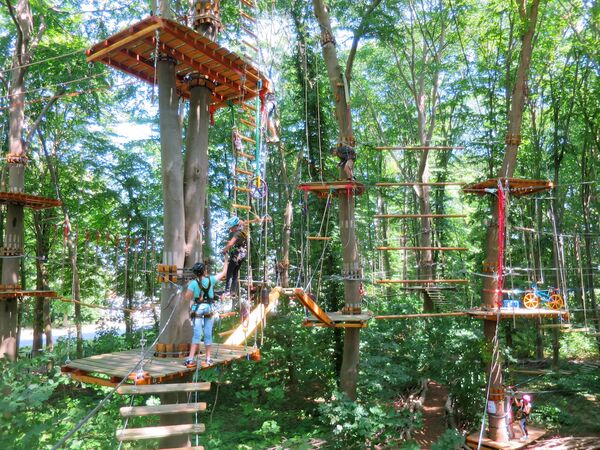
Climbing forest Greifswald
Relaxation in the countryside - the ecologically sustainable climbing forest offers fun for the whole family with no age restrictions. The all-round safety system reliably prevents accidental release.
The Greifswald climbing forest is an attractive excursion destination for the whole family. Especially for children of pre-school and primary school age, climbing is an extraordinary development opportunity and great fun. There are no age restrictions so that everyone can try it out to their heart's content. Climbing starts at a height of 0.5 meters for beginners. All elements are designed for two people to help each other. The "Safety-Line" lashing belay system reliably prevents unintentional release. Throughout your climbing training, a dedicated team is on hand with compassion, advice and support. Free parking is available directly at the north entrance of the Greifswald Volksstadion on Wolgaster Straße.
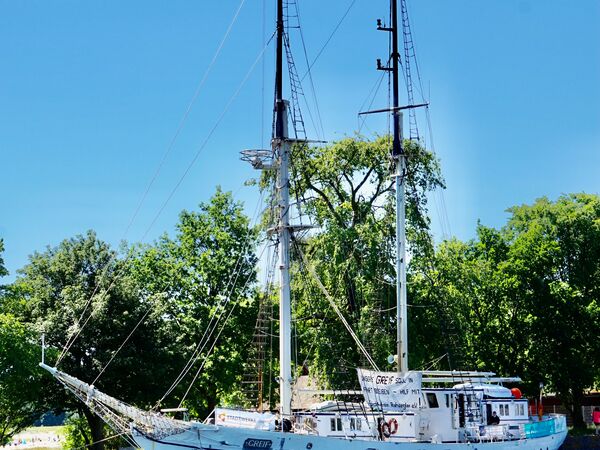
Sailing training ship Greif
Experience the historic schooner brig on a day trip or a Baltic Sea cruise lasting several days in the footsteps of the Hanseatic League!
The steel two-master with the characteristic square sails was built in 1951 at the Warnow shipyard in Warnemünde and put into service under the name "Wilhelm Pieck". Until 1990, it was the flagship of the GST naval school in Greifswald-Wieck and carried out training trips for young sailors.
After the political change, the ship was completely overhauled and rebuilt. Since then, it has been owned and operated by the Greif Seesport Center, a company owned by the University and Hanseatic City of Greifswald.
Under the name "GREIF", it sails as a civilian sailing school ship with volunteer and paying co-sailors and sails to the most beautiful ports in the North and Baltic Seas from April to October: Ystad, Copenhagen, Klaipeda, Gdansk and other places are on the itinerary every year.
A sail area of 570 m², spread over 15 sails, allows a speed of up to 14 knots. The ship is equipped in accordance with the latest safety regulations and has a sailing license as a sailing school ship. It is sailed by a professional crew and volunteer crew members from the "Rahsegler GREIF e.V." support association.
If you are looking for a special experience, the "GREIF" is the right boat for you. Incidentally, this is also possible without any previous experience: The experienced crew members of the team introduce new sailors to traditional seamanship step by step.
Welcome on board!
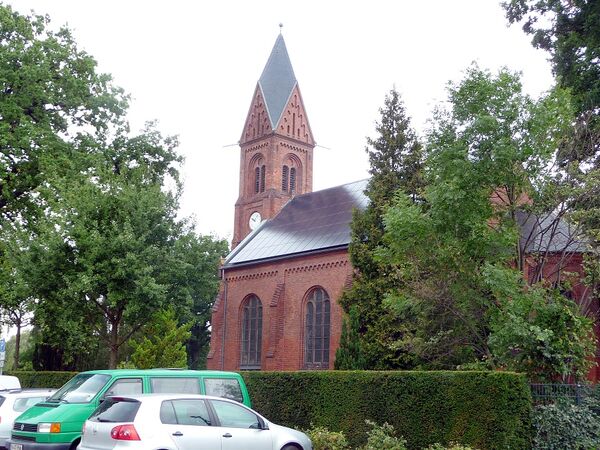
Greifswald-Wieck parish church
Concerts of the Greifswald Bach Week take place in the parish church of Greifswald-Wieck.
A church in Wieck was first mentioned in documents in the 13th century. However, it was not located on today's church square, but in the center of the village. After another church building became unusable due to storm flood damage, the new building, which had been postponed several times, was completed at the end of the 19th century. The neo-Romanesque church was completed in 1883. Worth seeing inside the church are the Mehmel organ, the pulpit and the ship models, which are a reminder of the seafaring tradition that shaped Wieck for centuries.
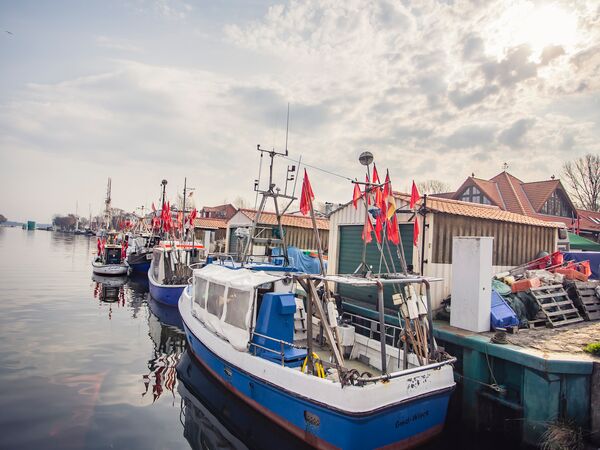
Sailing and fishing harbor Wieck
Wieck is one of the oldest fishing villages in northern Germany and is closely linked to the monastery in Eldena. Even back then, the fishing port on the River Ryck was an important outport for the town of Greifswald.
The listed fishing village of Wieck is located directly on the Greifswald Bodden. The village's landmark is the Wieck bascule bridge, built according to the Dutch model. Fishing in particular is still omnipresent here. Whether it's fish sandwiches, typical regional fish dishes or more unusual creations - there is a wide range of culinary delicacies on offer. Numerous fishing boats, yachts and sailing ships are lined up along the River Ryck, which flows into the Bodden here, underlining the maritime flair of the town. The beautiful promenade, where you will find wooden sculptures by international and local artists, and the direct beach location also invite you to take long walks. As a district of the Hanseatic city of Greifswald, there are also numerous entertainment options and excursion destinations away from the fishing village.
Fishing festival Gaffelrigg
The "Gaffellrigg" fishing festival traditionally takes place on the 3rd weekend in July in the Hanseatic city of Greifswald. It is the largest maritime festival in Western Pomerania and offers its guests numerous entertainment options as well as the eponymous Gaffellrigg with traditional and museum ships and a colorful supporting program.
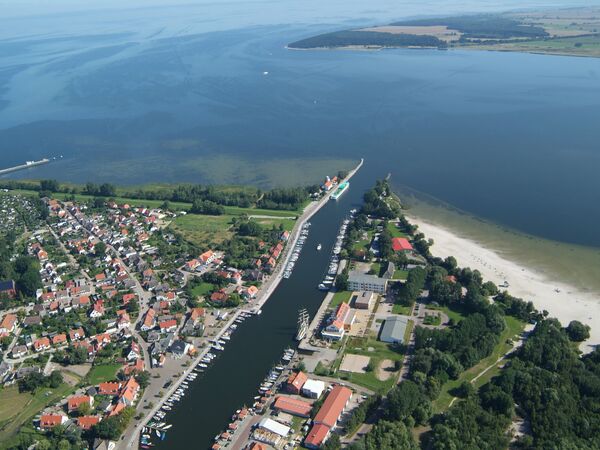
Sailing school Greifswald
Visit the idyllically situated sailing, surfing and sports boat school in Greifswald. Benefit from our expertise and wide range of courses for young and old. Guided kayak tours and boat hire are also available. Windsurfing in the Dänische Wiek and Greifswalder Bodden.
With us you will learn sailing, surfing and pleasure boating in one of the most beautiful surfing and sailing areas in Germany. You will find our well-equipped school in Greifswald/ Wieck, a tranquil fishing village directly at the mouth of the Ryck on the Greifswalder Bodden.
The school itself is housed in the former lido. Due to this unique, peninsula-like location, we have the enormous advantage that our yachts, motorboats and sailing dinghies are moored at our own jetty and mooring buoys.
We have our own beach access on the Danish Wieck for our surfers, Opti sailors and beach catamarans. This is a so-called standing area, so it is particularly pleasant and comfortable for all those who start from here.
The entire Danish Wieck, as well as the waters of the Greifswalder Bodden, are very safe due to their geographical location, as they are protected on all sides. The wind safety is enormous and the water warms up faster than elsewhere due to the shallow depth.
From April to October we also offer guided kayak tours, and you can also hire our boats or windsurfing equipment.
Stand up paddling boards are now also available for hire.
Large groups are also more than welcome, and there is even a special price list for them.
So..." Off to the water"!
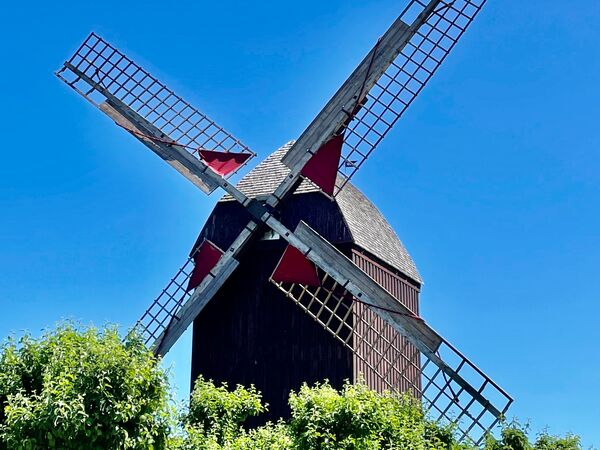
Eldena windmill
The Eldena mill is a trestle windmill.
The Eldena mill was built in the first half of the 18th century. It ceased operation in the 1930s. The windmill fell into disrepair over the following decades and finally collapsed in 1972. Thanks to the efforts of the Förderverein Eldenaer Mühle e.V., the inauguration of a mill reconstruction was celebrated in 2002. Visits can be arranged by telephone.
Every year, Whit Monday is German Mill Day. On this day, the historic mills open their doors.
The Secrets of the Griffin Dynasty" is a fascinating podcast series dedicated to one of the most important and mysterious families of medieval Europe - the Griffins, Pomeranian princes. The podcast is aimed at a wide audience: from history buffs to tourists planning a trip to Pomerania to parents with children who want to introduce the youngest to the region's beautiful but mysterious past.
Podcast - The Secrets of the Griffin Dynasty (Spotify)
Embedded in the present, the short novel "Holidays with the Griffins" skillfully takes us to the individual places on the Griffin route (in Poland, Sweden, Denmark, Germany) to find the treasures hidden centuries ago, which were brought to Pomerania by the only king among the Griffins, who was ruler of Scandinavia for almost half a century.
Audiobook - Audiobook "Holidays with the Griffins" (Spotify)
